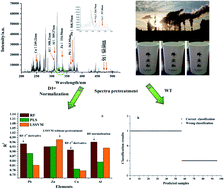当前位置:
X-MOL 学术
›
J. Anal. At. Spectrom.
›
论文详情
Our official English website, www.x-mol.net, welcomes your feedback! (Note: you will need to create a separate account there.)
Four-metal-element quantitative analysis and pollution source discrimination in atmospheric sedimentation by laser-induced breakdown spectroscopy (LIBS) coupled with machine learning
Journal of Analytical Atomic Spectrometry ( IF 3.4 ) Pub Date : 2019/12/17 , DOI: 10.1039/c9ja00360f Xin Zhang 1, 2, 3, 4, 5 , Nan Li 1, 2, 3, 4, 5 , Chunhua Yan 1, 2, 3, 4, 5 , Jiahui Zeng 1, 2, 3, 4, 5 , Tianlong Zhang 1, 2, 3, 4, 5 , Hua Li 1, 2, 3, 4, 5
Journal of Analytical Atomic Spectrometry ( IF 3.4 ) Pub Date : 2019/12/17 , DOI: 10.1039/c9ja00360f Xin Zhang 1, 2, 3, 4, 5 , Nan Li 1, 2, 3, 4, 5 , Chunhua Yan 1, 2, 3, 4, 5 , Jiahui Zeng 1, 2, 3, 4, 5 , Tianlong Zhang 1, 2, 3, 4, 5 , Hua Li 1, 2, 3, 4, 5
Affiliation

|
The laser-induced breakdown spectroscopy (LIBS) technique coupled with random forest (RF) and least squares support vector machine (LSSVM) methods was proposed to perform the quantitative and classification analyses of atmospheric sedimentation. The LIBS spectra of 16 atmospheric sedimentation samples with different locations were obtained via the LIBS measurement system, and the major elements of the atmospheric sedimentation samples were identified by the National Institute of Standards and Technology (NIST) database. For quantitative analysis, first, the best pretreatment method needs to be selected to process the LIBS spectra of the four metal elements (Pb, Cu, Zn and Al) of atmospheric sedimentation samples obtained from 16 locations. Then, RF, LSSVM and PLS calibration models were constructed with the optimal pretreatment spectra as input variables. The performances of the three calibration models were compared by the correlation coefficient of cross-validation (RCV2) and root mean square error of cross-validation (RMSECV) to obtain an optimal model. Finally, the optimal model was verified by the correlation coefficient of prediction (RP2) and root mean square error of prediction (RMSEP). The satisfactory quantitative results of Pb, Cu and Al are the RF calibration model, and Zn is the LSSVM calibration model. For classification analysis, first, the best pretreatment method needs to be selected to process the LIBS spectra of the atmospheric sedimentation samples. Then, RF, LSSVM and PLS-DA were constructed with the best pretreatment spectra as input variables. Finally, the five factors, i.e., accuracy, sensitivity, precision, specificity and area under curve (AUC) were used to evaluate the predictive performance of the three classification models, and the LSSVM classification model exhibited better prediction in pollution source discrimination. It was confirmed that the LIBS technique coupled with the RF and LSSVM methods is a promising approach to achieve the analysis of atmospheric sedimentation.
中文翻译:

激光诱导击穿光谱法(LIBS)结合机器学习对大气沉降中的四金属元素定量分析和污染源识别
提出了激光诱导击穿光谱(LIBS)技术,结合随机森林(RF)和最小二乘支持向量机(LSSVM)方法对大气沉降进行定量和分类分析。得到的与不同的位置16个的大气沉降样品的LIBS光谱经由美国国家标准技术研究所(NIST)的数据库确定了LIBS测量系统以及大气沉降样品的主要成分。为了进行定量分析,首先,需要选择最佳的预处理方法来处理从16个地点获得的大气沉降样品的四种金属元素(Pb,Cu,Zn和Al)的LIBS光谱。然后,以最佳预处理光谱作为输入变量,构建RF,LSSVM和PLS校准模型。通过交叉验证的相关系数(R CV 2)和交叉验证的均方根误差(RMSECV),以获得最佳模型。最后,通过预测的相关系数(R P 2)和预测的均方根误差(RMSEP)验证了最优模型。Pb,Cu和Al令人满意的定量结果是RF校准模型,而Zn是LSSVM校准模型。对于分类分析,首先,需要选择最佳的预处理方法来处理大气沉积样品的LIBS光谱。然后,以最佳预处理光谱作为输入变量构建RF,LSSVM和PLS-DA。最后,五个因素,即,准确度,灵敏度,精确度,特异性和曲线下面积(AUC)用于评估这三种分类模型的预测性能,而LSSVM分类模型在污染源识别方面表现出更好的预测。可以肯定的是,LIBS技术与RF和LSSVM方法相结合是实现大气沉降分析的一种有前途的方法。
更新日期:2020-02-13
中文翻译:

激光诱导击穿光谱法(LIBS)结合机器学习对大气沉降中的四金属元素定量分析和污染源识别
提出了激光诱导击穿光谱(LIBS)技术,结合随机森林(RF)和最小二乘支持向量机(LSSVM)方法对大气沉降进行定量和分类分析。得到的与不同的位置16个的大气沉降样品的LIBS光谱经由美国国家标准技术研究所(NIST)的数据库确定了LIBS测量系统以及大气沉降样品的主要成分。为了进行定量分析,首先,需要选择最佳的预处理方法来处理从16个地点获得的大气沉降样品的四种金属元素(Pb,Cu,Zn和Al)的LIBS光谱。然后,以最佳预处理光谱作为输入变量,构建RF,LSSVM和PLS校准模型。通过交叉验证的相关系数(R CV 2)和交叉验证的均方根误差(RMSECV),以获得最佳模型。最后,通过预测的相关系数(R P 2)和预测的均方根误差(RMSEP)验证了最优模型。Pb,Cu和Al令人满意的定量结果是RF校准模型,而Zn是LSSVM校准模型。对于分类分析,首先,需要选择最佳的预处理方法来处理大气沉积样品的LIBS光谱。然后,以最佳预处理光谱作为输入变量构建RF,LSSVM和PLS-DA。最后,五个因素,即,准确度,灵敏度,精确度,特异性和曲线下面积(AUC)用于评估这三种分类模型的预测性能,而LSSVM分类模型在污染源识别方面表现出更好的预测。可以肯定的是,LIBS技术与RF和LSSVM方法相结合是实现大气沉降分析的一种有前途的方法。

























 京公网安备 11010802027423号
京公网安备 11010802027423号